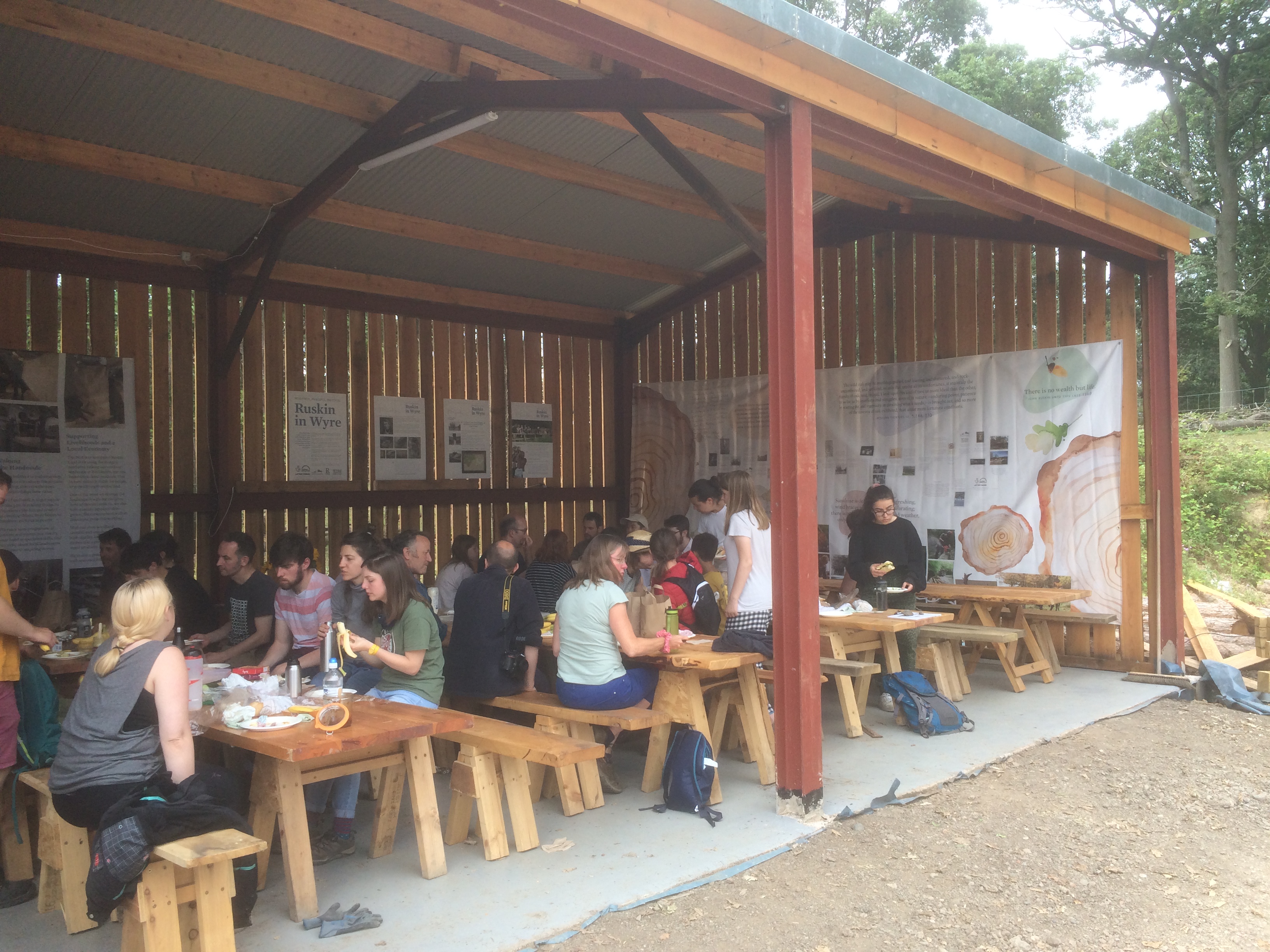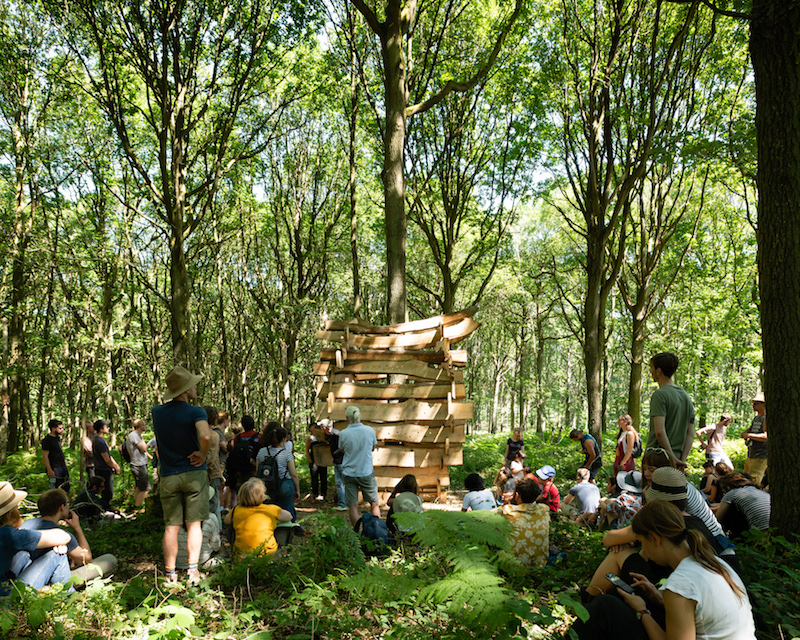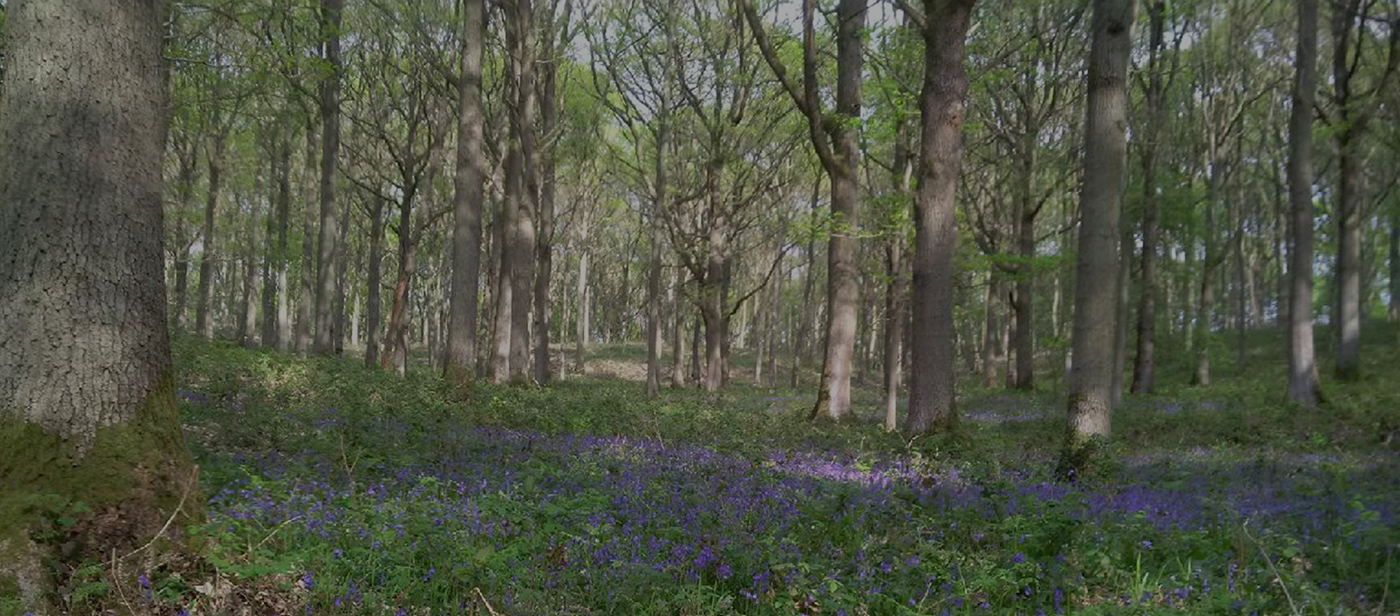Ruskin Land, gifted to the Guild in the 1870s, is made up of a hundred acres of mostly oak woodland, two farmhouses, a cottage, a sawmill and an orchard and wildflower meadow. Much of it is managed by our partners, the Wyre Community Land Trust, in close co-operation with the Guild. Tenants at Uncllys Farm and St George's bungalow each run their own land-based activity from the site. Together, we welcome many visitors, volunteers and other partners to share in the beauty, work and learning offered by this very special place.
Our partners, the Wyre Community Land Trust
Since 2007, the Wyre Community Land Trust (WCLT) has been working to conserve the Wyre Forest and its variety of habitats, including its species rich wildflower meadows, traditional orchards and wood pasture. They work in close partnership with the Guild and with Natural England, Forestry England, Worcestershire Wildlife Trust, The Woodland Trust, Butterfly Conservation and local landowners.
Their team of around 40 dedicated volunteers help them carry out important conservation work and care for their herd of 50 pedigree Dexter cattle that carry out an extensive conservation grazing programme.
They provide opportunities for individuals and groups to visit and learn about the natural environment and heritage crafts. This includes their education and care farming programme in partnership with the Guild, local community organisations and schools, as well as courses and events programme.
FIND OUT MORE HERE
University of Birmingham & the Birmingham Institute of Forest Research (BIFoR)
At Ruskin Land, we have an evolving relationship with our friends and academic partners at the University of Birmingham, led by Prof John Holmes. John is working to engage people in the climate change discussion through the arts and humanities, which can play an important part in raising awareness and offering solutions, alongside the more traditional science subjects.
One of the projects emerging from this collaboration are two new virtual tours of Ruskin Land developed with the Birmingham Institute of Forest Research (BIFoR). You can find the virtual tours of Ruskin Land, focused on Walking with JRR Tolkien in the Wyre Forest, and Walking with John Ruskin in the Wyre Forest, HERE.
In 2023, John Holmes wrote: We will create two full tours on top of the existing structure. One of these, building on Dion Dobrzynski’s PhD research, will focus on how fantasy helps us to think about, engage with and respond to forests. The other, mobilising research conducted for the AHRC bid ‘John Ruskin and Environmental Justice’, will trace connections between Ruskin’s ideas and current environmental problems and solutions. These two tours will provide additional learning resources for BIFoR’s online education platform as a parallel to the virtual tour of the FACE Facility site, as well as forming educational and promotional material for the Guild.
You can watch John Holmes talking about this work, as part of the University's response to COP28, in the video below.
Read more about the evolution of Ruskin Land since the 1870s, in this account from 2017 by Companion Neil Sinden.
Read NATURE NOTES, a beautiful illustrated monthly diary from a resident of Ruskin Land, Linda Iles, here.
Many groups and individuals visit Ruskin Land each year and it hosts local, regional and national collaborations which benefit from the resources of this area of outstanding natural beauty, and from the skills and expertise of the people who live and work on the land. The Guild is supporting work to regenerate the old orchards, hay meadows and oak woodland, and it helped to build an architecturally striking study centre on its land, The Ruskin Studio.
The land was given to Ruskin in the 1870s and has been managed by the Guild since then. The mission of Ruskin’s Guild was, in his words, ‘to take some small piece of English Land, beautiful, peaceful and fruitful’, to provide opportunities for working people to cultivate land and reconnect with nature. Ruskin’s ideas remain relevant today and it is our mission to reinterpret them in meaningful, creative and productive ways for a new generation.
The c HLF-supported Ruskin in Wyre project (2017-19) aimed to explore what happened at Ruskin Land and how Ruskin’s ideas have been incorporated into the modern forest.
The project deepened the links between the community and the forest through a wide range of events and activities. Making, of all kind and varieties, was a key part of the project and it provided opportunities for people to work with our artist in residence using our oak to create beautiful things.
Studio in the Woods at Ruskin Land, summer 2018 & 2019
In the summers of 2018 and 2019, the oak woodland at Ruskin Land was the venue for the annual Studio in the Woods project, hosted by the Wyre Community Land Trust. Studio in the Woods is an ongoing education and research project established in 2005. It was founded and is convened by Piers Taylor (Invisible Studio) with Kate Darby (Kate Darby Architects), Meredith Bowles (Mole) and Gianni Botsford (Gianni Botsford Architects) as a vehicle to test ideas through making at 1:1. At Ruskin Land the challenge was to work only with waste wood, the timber that otherwise had no commercial value or purpose.
Each year the founders have been joined by a number of other practitioners and academics in leading workshops with students (architects, makers, artists, academics) over 3 or 4 days in summer time. To watch a film about this remarkable project, see below.
Studio in the Woods, 2018 from Stephenson& on Vimeo.


The history of Ruskin in Wyre
“We will try to take some small piece of English ground, beautiful, peaceful and fruitful. We will have no steam-engines upon it, and no railroads; we will have no untended or unthought-of creatures on it; none wretched, but the sick; none idle, but the dead.”
Ruskin’s initial hopes for the land he was given in the Wyre Forest provide a sense of his utopian vision which remains inspirational to this day. It arose from his reaction to the ravages of the industrial revolution on the environment and humankind. But the forest at that time was itself an industrial landscape, supporting a wide range of economic activity including coppicing and making charcoal for iron smelting, bark stripping for the nearby tanneries, basket, besom and hurdle making.
It was George Baker, a Quaker businessman and local politician, who offered Ruskin some land in the Wyre Forest to make a practical reality of his ideas. Baker lived at Beaucastle, the imposing neo-gothic mansion on the edge of the forest just off the Bewdley to Cleobury road.
He originally gave 7 acres in 1871, later increasing his gift to 20 acres in 1877, the year that Ruskin paid his only visit to the area when he described the bequest as “in midst of a sweet space of English hill, dale and orchard, yet unhurt by the hand of man.” He had plans drawn up for a museum at Ruskin Land which were never realised, his only St George's Museum eventually being opened on the edge of Sheffield.
After the land was cleared of trees, William Graham, one of Ruskin’s early followers, set about establishing a smallholding at what was then known as the St George’s Guild Bewdley Estate. In 1880 he drew a plan for an orchard of 180 or so fruit trees, a mixture of varieties of plum, damson, apple, pear and cherry.
Graham worked there for 8 years, planting and tending the young orchard, raising pigs and growing various crops. Sadly, he left after falling out with Ruskin who he felt had failed to provide adequate support for his efforts. William Graham is buried, with his wife Eliza in St Leonard’s Churchyard in Ribbesford.
Shortly after Ruskin’s death in 1900, the Guild resolved to build a cottage at Ruskin Land. St George’s Farmhouse was completed in 1908 and a few years later Frederick and Ada Watson moved in with their daughter Eva and sons Harry and Willy. The Watsons were members of the Liverpool Ruskin Society where they previously lived.
They followed in the footsteps of fellow members of the Society, Margaret and Thomas Harley, and Edith Hope Scott who had moved to the Wyre Forest a few years before. Together they formed the nucleus of a small Ruskinian community. The Watsons remained at St George’s Farm for almost thirty years working the land and selling their produce at local markets.
After Frederick suffered a stroke, the Watsons returned to Liverpool in 1938. It wasn’t until after the war that the Guild found new tenants for St George’s Farm. In 1956 Jack and Nancy Bishop took over the farm and raised a family there until Jack moved into a local hospice in 2014 shortly before passing away.
They combined running the smallholding, rearing turkeys and cattle (having grubbed up the original orchard), with Jack working as a ‘loom tuner’ at Brintons, a carpet factory in Kidderminster. While they are fondly remembered by members of the local community, the Bishops had no particular attachment to Ruskin or the Guild of St George, who were content to ensure that Ruskin Land was being farmed.
In the last two decades, and in partnership with the Wyre Community Land Trust, the Guild has begun a long-term project to revitalise the management and care of Ruskin Land, to ensure that it will remain ‘beautiful, peaceful and fruitful’ for centuries to come.
A Ruskin Land timeline
1819 John Ruskin born in Denmark Hill, London
1862 Unto this Last - one of Ruskin’s most influential books - is published
1871 Ruskin begins to write Fors Clavigera, acquires Brantwood by Coniston Water in the Lake District and is offered 7 acres of land in the Wyre Forest, increased to 20 acres six years later, by George Baker
1875 Ruskin establishes a museum at Walkley, a suburb of Sheffield
1878 William Graham begins work at Ruskin Land and John Ruskin visits Bewdley with George Baker whose house Beaucastle was completed in the same year
1880 An orchard is planted at Ruskin Land based on plan drawn up by Graham
1883 Liverpool Ruskin Society is formed whose members included members of the Fowler, Harley, Wardle, Watson and Quayle families, as well as Edith Hope-Scott
1885 Joseph Southall is commissioned to design a museum at Bewdley
1895 National Trust is formed by Octavia Hill, Robert Hunter and Canon Rawnsley, inspired by Ruskin
1900 Ruskin dies at Brantwood
1909 William Graham dies and is buried at St Leonard’s, Ribbesford
1908 St George’s Farm is built at Ruskin Land
1911 Frederick and Ada Watson move from Liverpool to St George’s Farm with their children Harry, Willy and Eva
1914 Charles Clucas Quayle and his wife Mary Margaret move to Uncle’s Farm, later renamed Uncllys Farm, with their children Cuthbert, Kathleen and Kendrick
1921 The book The Beloved by Edith Hope-Scott about life at Ruskin Land is published
1925 Eliza Graham (nee Tart) William’s wife dies and is buried alongside him at Ribbesford
1929 The Quayle family moves to Bowcastle Farm
1930 Guild of St George acquires 100 acres of woodland around Ruskin Land, along with the neighbouring smallholding Uncllys Farm
1938 The Watsons return to Liverpool and Clucas Quayle dies leaving his elder son Cuthbert to look after the Guild property, including Ruskin Land
1956 Jack and Nancy Bishop move into St George’s Farm with their family removing the original orchard shortly after
1969 Cuthbert Quayle dies and Cedric Quayle, son of his younger brother Kendrick, starts to look after Guild property in the Wyre Forest
1978 Over 200 ha of the Wyre Forest, including Ruskin Land, becomes a National Nature Reserve
1989 The booklet Ruskin and Bewdley by Peter Wardle and Cedric Quayle is published
2007 Wyre Community Land Trust set up by John and Linda Iles based at Uncylls Farm
2009 Work begins on constructing the oak-framed Ruskin Studio by covering an old outbuilding at Uncllys Farm
2014 Mark Frost’s The Lost Companions and John Ruskin’s Guild of St George: a Revisionary History is published
2015 Lynne Roberts and Neil Sinden move into St George’s Farm and with CLT staff and volunteers start to plant a new orchard there
2016 Wyre CLT’s new Managing Director, Tim Selman, oversees its relocation to St George’s Farm and the establishment of a woodyard at Ruskin Land
2017 Wyre CLT and Guild of St George secure a Heritage Lottery Grant to tell the story of Ruskin Land
PRESENT DAY: The Wyre Community Land Trust continues to offer a wide range of access and opportunity for different groups to engage with and learn from Ruskin Land. In addition, the Guild is working with other partners to further widen the use of Ruskin Land for the public good; we have a fruitful partnership with the University of Birmingham and their Institute of Forest Research, BIFoR.

